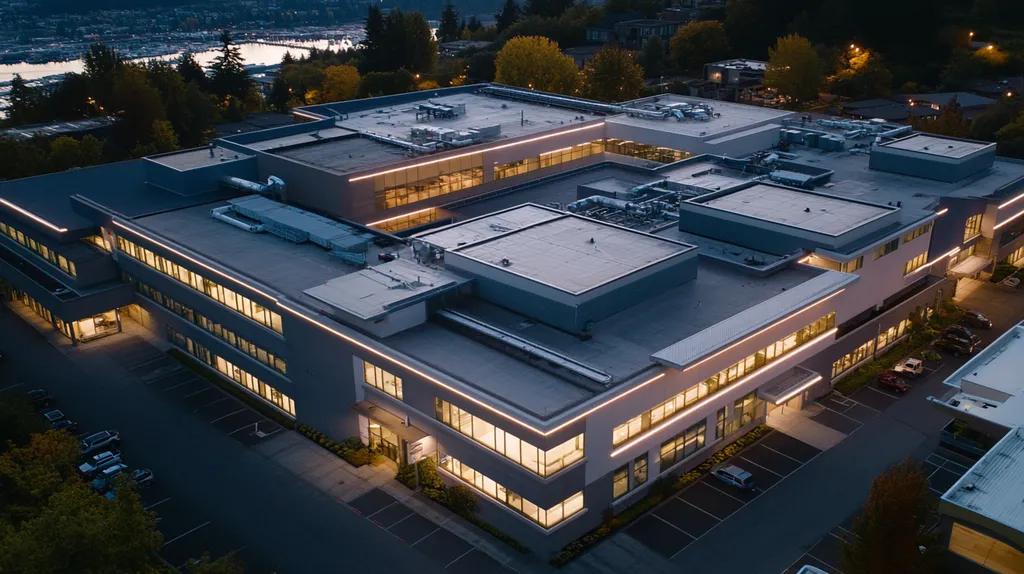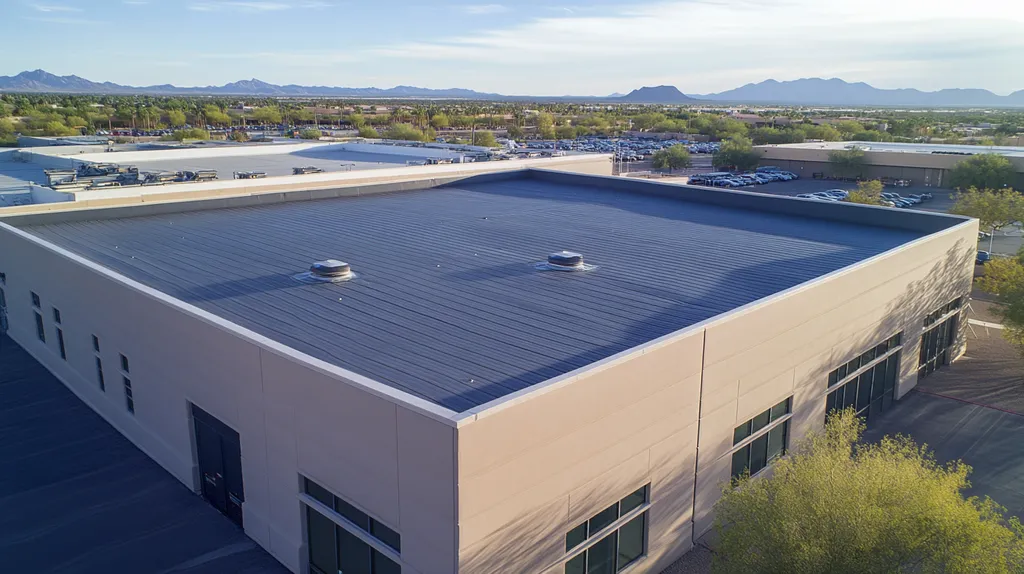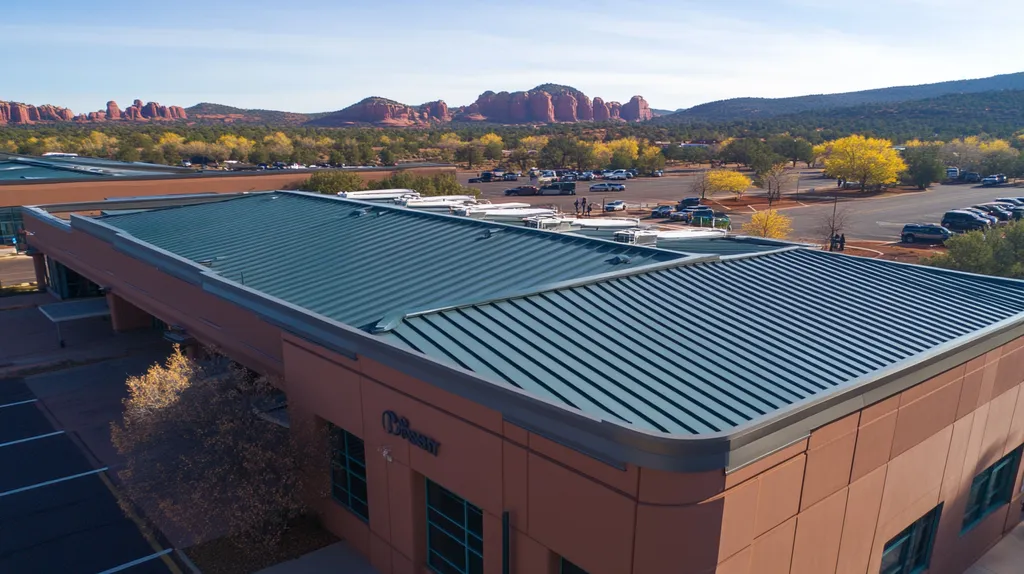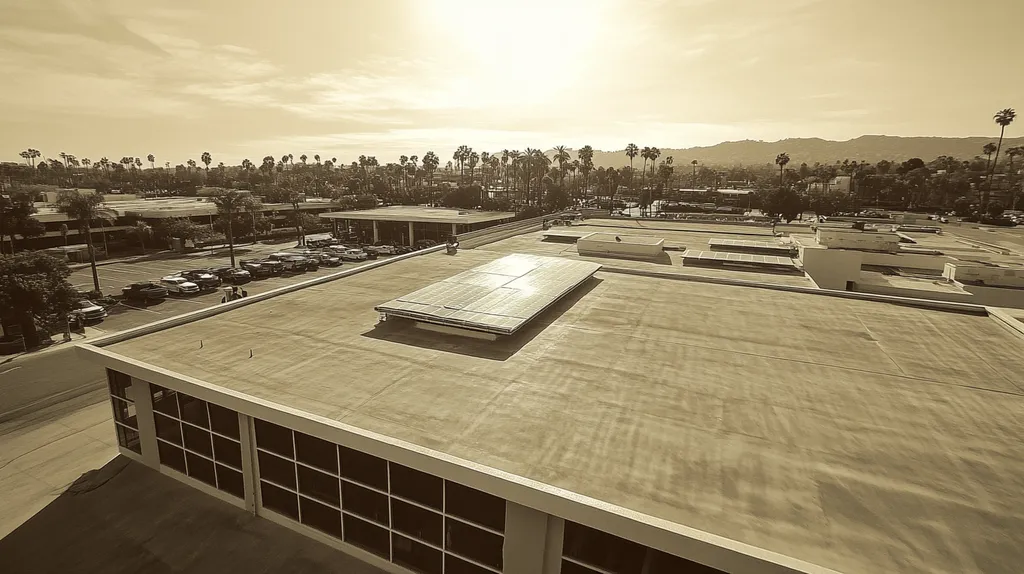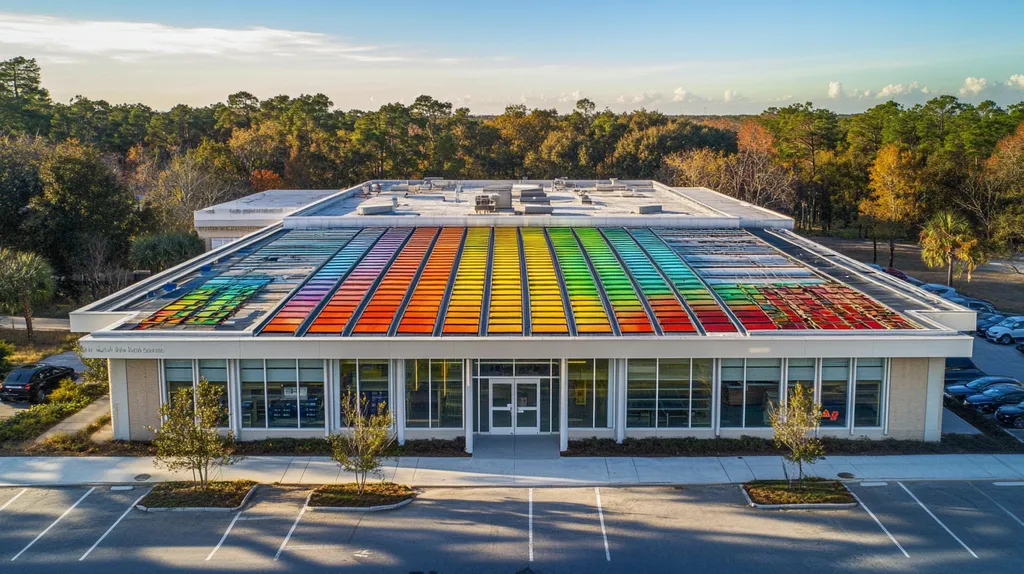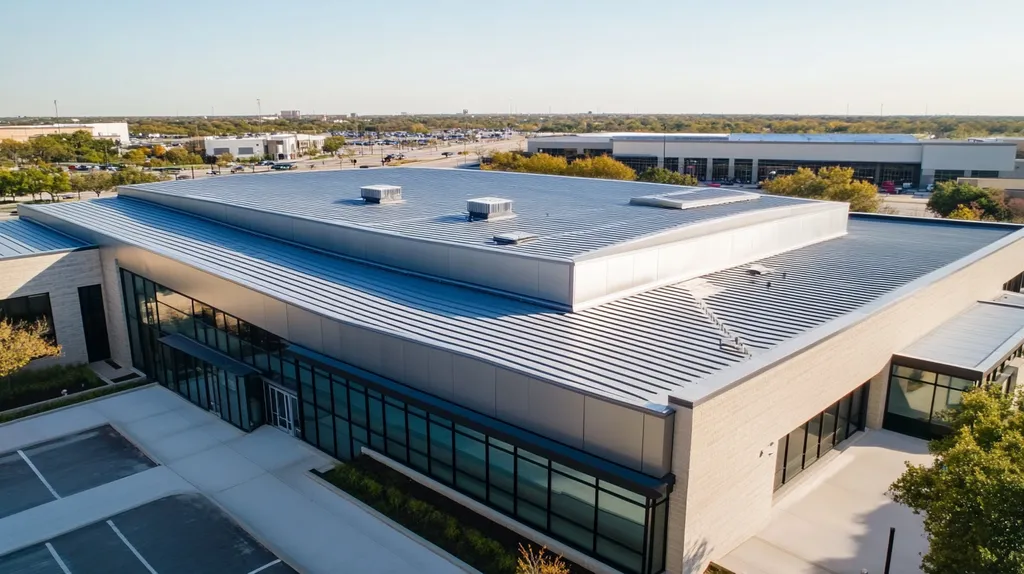Welcome to today’s Battle Royale featuring two roofing heavyweights: “TPO” in the east corner versus “PVC” in the west!
Tonight’s showdown pits these contenders against each other across six punishing rounds designed to test every aspect of their performance for Industrial Roof Warranty Issues.
At stake? Millions in potential costs, decades of building protection, and the critical performance demands of modern commercial and industrial facilities.
Our professional judging panel will evaluate each round on technical merit, real-world performance, and value delivery. After all six rounds, we’ll declare our ultimate champion.
Ladies and gentlemen, facility managers and building owners… it’s time to rumble!
ROUND 1: INITIAL COSTS & INSTALLATION
When it comes to industrial roofing, getting the installation right is like setting up dominos – one misstep and the whole warranty can come crashing down. With material costs skyrocketing and skilled labor in short supply, property managers can’t afford to stumble on their initial roofing decisions.
Both TPO and PVC membranes promise durability and performance, but their upfront costs and installation requirements tell very different stories. Let’s examine how these heavyweight contenders stack up in the crucial first round.
Material Expenses
TPO enters the ring as the budget-friendly challenger, typically costing 20-30% less than its PVC counterpart. However, like that “great deal” on a used car, the sticker price doesn’t tell the whole story.
While TPO manufacturers have improved their formulations, the membrane’s cost advantage often comes with trade-offs in chemical resistance and seam strength. These limitations can lead to more frequent repairs and shorter service life.
PVC commands premium pricing, but delivers enhanced resistance to chemicals, oils, and environmental pollutants. Its superior weldability and proven track record of lasting performance help justify the higher initial investment.
ADVANTAGE: TPO (purely on initial cost considerations)
Installation Complexity
TPO installation is relatively straightforward, requiring basic heat-welding skills and standard roofing tools. This simplicity reduces the risk of installation errors that could void warranties.
However, TPO’s easier installation can create a false sense of security. Some contractors may rush the job or cut corners, leading to problems that only surface after the warranty period begins.
PVC demands more sophisticated welding techniques and experienced installers. While this increases labor costs, it also ensures better quality control and reduces the likelihood of installation-related warranty issues.
ADVANTAGE: TIE (TPO wins on simplicity, PVC on quality assurance)
Project Timeline
Speed matters in commercial roofing, where every day of installation means potential disruption to business operations. TPO’s simpler installation process typically results in faster project completion.
PVC installations require more time for proper seam welding and detail work. This methodical approach extends project timelines but delivers more reliable long-term performance.
The extended installation time for PVC can increase exposure to weather risks and impact tenant operations. However, rushing installation to meet aggressive timelines remains a leading cause of warranty disputes.
ADVANTAGE: TPO
ROUND 1 WINNER: TPO
ROUND 2: DURABILITY & LIFESPAN
In the high-stakes arena of industrial roofing, a membrane’s durability isn’t just about longevity – it’s about protecting millions in assets and operations. While TPO and PVC both claim championship-level performance, their true mettle shows only after years of punishment from UV rays, chemical exposure, and weather extremes.
Property managers betting their buildings on the wrong material often discover too late that their warranty coverage has more holes than their roof. Let’s see how these contenders hold up when the gloves come off and real-world conditions start swinging.
Material Resilience
TPO enters this round with impressive flexibility credentials, demonstrating solid puncture resistance and the ability to handle building movement without cracking. Its weldable seams create a monolithic surface that, when properly installed, can resist basic wear and tear.
However, TPO’s Achilles’ heel emerges in environments with heavy chemical exposure or extreme heat cycling. Some formulations become brittle over time, leading to premature aging and potential membrane failure.
PVC counterpunches with superior chemical resistance and proven long-term performance in harsh industrial environments. Its hot-air welded seams actually strengthen over time, unlike TPO’s which can weaken under sustained UV exposure.
ADVANTAGE: PVC
Weather Resistance
TPO’s reflective surface helps it deflect UV rays and regulate roof temperatures, reducing thermal stress on the membrane. This characteristic particularly shines in hot climates where heat aging poses a significant threat.
Yet TPO shows vulnerability when facing sustained high temperatures or frequent thermal cycling. Some older formulations have demonstrated accelerated deterioration under these conditions.
PVC demonstrates remarkable resilience across all climate zones, maintaining its protective properties despite decades of weather abuse. Its superior plasticizer retention prevents the brittleness that often plagues other materials in cold conditions.
ADVANTAGE: PVC
Maintenance Requirements
TPO demands vigilant maintenance to preserve its warranty coverage. Regular inspections must check for seam failures, surface degradation, and chemical exposure that could compromise the membrane’s integrity.
The membrane’s sensitivity to certain chemicals means facility managers must carefully monitor roof exposure to industrial exhaust, grease, or other contaminants. Overlooking these maintenance requirements often leads to warranty disputes.
PVC requires less intensive maintenance thanks to its inherent chemical resistance and proven longevity. Its better aging characteristics mean fewer emergency repairs and lower long-term maintenance costs.
ADVANTAGE: PVC
ROUND 2 WINNER: PVC
ROUND 3: PERFORMANCE FACTORS
In the high-stakes world of industrial roofing, performance failures can cascade into catastrophic warranty voids and six-figure repair bills. Every year, thousands of facility managers discover their roofing investment crumbling because they overlooked critical performance factors during material selection.
When comparing TPO and PVC membranes, seemingly minor performance differences can spell the difference between decades of protection and premature failure. Let’s examine how these industrial heavyweights measure up where it matters most.
Chemical Resistance
Industrial environments bombard roofing membranes with a toxic cocktail of chemical exposures. From HVAC condensation to industrial exhaust, these constant chemical attacks can quickly degrade inferior materials and void warranties.
TPO shows vulnerability when exposed to certain industrial chemicals and oils. Its molecular structure can break down under sustained chemical exposure, leading to premature aging and potential membrane failure.
PVC demonstrates superior resistance to harsh chemicals, oils, and industrial pollutants. Its unique formulation creates a nearly impenetrable barrier that maintains integrity even in the most demanding chemical environments.
ADVANTAGE: PVC
Seam Strength
Seam failures represent one of the leading causes of warranty disputes in industrial roofing. As membranes expand and contract with temperature changes, weak seams can separate and create entry points for moisture.
TPO seams rely heavily on proper heat welding during installation. While initially strong, these seams can weaken over time, especially when subjected to frequent thermal cycling and UV exposure.
PVC seams actually strengthen over time through a unique chemical bonding process. This self-reinforcing characteristic creates virtually indestructible joints that resist separation even under extreme stress.
ADVANTAGE: PVC
Impact Resistance
Industrial roofs must withstand everything from maintenance foot traffic to falling debris. Impact damage that penetrates the membrane can instantly void warranties and require costly repairs.
TPO exhibits impressive initial puncture resistance and flexibility. Its ability to absorb impacts without cracking makes it particularly suitable for facilities with frequent rooftop traffic.
PVC offers moderate impact resistance but can become less flexible in cold temperatures. While still durable, it may require additional protection in high-traffic areas or regions with severe hail risk.
ADVANTAGE: TPO
ROUND 3 WINNER: PVC
ROUND 4: MAINTENANCE REQUIREMENTS
In the high-stakes world of industrial roofing, maintenance missteps can transform a million-dollar investment into a warranty nightmare faster than a summer storm. Each year, thousands of property managers discover their warranties voided because they missed critical maintenance requirements or used the wrong cleaning products.
Both TPO and PVC membranes demand specific care routines to maintain their warranty coverage, but the devil lurks in the details. Let’s examine how these roofing heavyweights compare when it comes to keeping their warranties intact through proper maintenance.
Inspection Requirements
Regular inspections form the backbone of any roofing warranty compliance program. The frequency and depth of these inspections can mean the difference between continued coverage and a voided warranty.
TPO membranes demand quarterly professional inspections to maintain warranty coverage, with special attention to seam integrity and surface degradation. Even minor oversights in documentation can give manufacturers grounds for warranty denial.
PVC systems typically require only bi-annual professional inspections, focusing primarily on drainage systems and mechanical damage. This reduced inspection burden makes long-term warranty compliance more achievable for most facilities.
ADVANTAGE: PVC
Chemical Exposure Management
Industrial environments constantly assault roofing membranes with harsh chemicals, making proper exposure management critical for warranty preservation. Failure to document and address chemical exposure represents one of the leading causes of warranty disputes.
TPO requires constant vigilance against chemical contamination, with strict cleaning protocols for even minor spills. The membrane’s sensitivity to certain solvents means maintenance teams must carefully vet all cleaning products.
PVC’s superior chemical resistance translates to simpler maintenance requirements. Standard cleaning products and procedures generally won’t compromise the membrane’s integrity or warranty status.
ADVANTAGE: PVC
Repair Protocols
When damage occurs, following manufacturer-approved repair procedures becomes crucial for maintaining warranty coverage. Getting repairs wrong can void warranties faster than the original damage.
TPO repairs demand precise temperature control and specific welding techniques. The margin for error is slim, requiring certified technicians for even minor patches to maintain warranty compliance.
PVC membranes offer more forgiving repair parameters, with stronger weld bonds and better compatibility between new and weathered materials. This flexibility helps maintain warranty coverage even through multiple repair cycles.
ADVANTAGE: PVC
ROUND 4 WINNER: PVC
ROUND 5: SUSTAINABILITY CREDENTIALS
With ESG mandates reshaping commercial real estate and rising energy costs hammering bottom lines, roofing sustainability has evolved from eco-friendly wishlist to warranty-critical requirement. Today’s industrial facilities face mounting pressure to reduce their environmental impact while maintaining bulletproof warranty protection.
Both TPO and PVC membranes promise sustainable solutions, but their environmental credentials and warranty implications tell very different stories. Let’s examine how these contenders perform when the fight moves to the green corner.
Environmental Manufacturing Impact
TPO production creates significantly fewer harmful byproducts than traditional roofing materials. The membrane’s chlorine-free formulation and lower energy manufacturing process result in reduced environmental impact from cradle to installation.
However, TPO’s environmental benefits can be compromised by quality control issues during manufacturing. Some manufacturers cut corners on stabilizers and fire retardants, leading to premature degradation that voids warranties.
PVC manufacturing remains an energy-intensive process that produces chlorine-based byproducts. While modern plants have reduced emissions, the membrane’s production still carries a heavier environmental footprint than TPO.
ADVANTAGE: TPO
Energy Performance
TPO’s highly reflective surface delivers impressive energy savings in cooling-dominated climates. The membrane’s ability to maintain reflectivity over time helps facilities consistently meet energy code requirements and maintain warranty compliance.
However, TPO’s reflectivity can work against it in heating-dominated regions. The increased heating load can strain HVAC systems and potentially accelerate membrane aging through thermal cycling.
PVC offers comparable initial reflectivity but typically shows faster degradation of its reflective properties. This decline can impact building energy performance and create warranty issues if energy efficiency requirements aren’t met.
ADVANTAGE: TPO
End-of-Life Considerations
TPO membranes present significant recycling challenges due to their complex polymer blend. Many facilities struggle to find recycling options when replacing TPO roofs, often resulting in landfill disposal.
The membrane’s limited recyclability creates disposal headaches for facility managers and can conflict with corporate sustainability goals. Some warranties now include specific disposal requirements that must be met.
PVC boasts superior recyclability, with established programs for processing old membranes into new roofing products. This circular economy approach helps facilities meet waste reduction targets while maintaining warranty compliance.
ADVANTAGE: PVC
ROUND 5 WINNER: TPO
ROUND 6: SPECIALIZED APPLICATIONS
When industrial roofing goes wrong in specialized applications, the financial impact can be devastating. Every year, thousands of facility managers discover their warranties invalidated because their membrane choice couldn’t handle unique operational demands.
From chemical processing plants to cold storage facilities, specialized applications create extreme challenges that can quickly expose weaknesses in roofing systems. Let’s examine how our contenders perform when pushed beyond typical commercial use.
Chemical Processing Environments
Industrial chemical exposure represents one of the most brutal tests any roofing system can face. Even brief contact with the wrong substance can trigger a chain reaction of deterioration that spreads across the entire roof surface.
TPO membranes show significant vulnerability in chemical processing environments. Their molecular structure can break down when exposed to certain solvents, oils, and industrial chemicals, leading to premature failure and voided warranties.
PVC thrives in chemical-heavy settings, with exceptional resistance to acids, bases, and industrial solvents. Its proven chemical stability helps maintain warranty coverage even in the harshest processing environments.
ADVANTAGE: PVC
High-Temperature Applications
Extreme heat from industrial processes can cook standard roofing materials from the inside out. Without proper material selection, warranties become meaningless as membranes deteriorate under thermal assault.
TPO struggles in high-temperature applications, particularly when exposed to sustained heat above 160°F. Some formulations show accelerated aging and embrittlement when subjected to constant thermal loads.
PVC maintains its structural integrity even under extreme thermal conditions. Its superior heat stability and better plasticizer retention help preserve warranty coverage in high-temperature environments.
ADVANTAGE: PVC
Cold Storage Facilities
Temperature differentials in cold storage applications create unique challenges for roofing systems. Improper maintenance or installation in these environments can quickly lead to warranty-voiding issues. (source: Texas Select Construction)
TPO performs adequately in cold storage applications when properly installed with vapor barriers. However, its seams can become stressed under extreme thermal cycling, potentially compromising warranty coverage.
PVC demonstrates excellent dimensional stability in cold storage environments. Its superior weld strength and resistance to thermal movement help maintain warranty compliance even under severe temperature fluctuations.
ADVANTAGE: PVC
ROUND 6 WINNER: PVC
AND THE WINNER IS…
After six grueling rounds of technical analysis, with millions in facility protection on the line, we have our undisputed industrial roofing champion…
PVC takes the title with a commanding 4-2 victory over TPO!
The champion’s superior chemical resistance, exceptional durability, and bulletproof seam strength proved decisive in this heavyweight bout. PVC dominated the critical rounds of durability, performance, maintenance, and specialized applications – areas where warranty claims often hit hardest.
However, don’t count TPO out completely. Its lower initial costs and impressive sustainability credentials make it a serious contender for facilities with limited budgets or aggressive environmental goals. When chemical exposure is minimal and installation expertise is readily available, TPO can deliver solid performance.
IMPORTANT NOTICE: This analysis reflects general industry trends and typical application scenarios. Individual building requirements, local climate conditions, and specific facility operations can significantly impact roofing system performance. Property owners and managers should always consult qualified roofing professionals who can evaluate their unique situation before making final material selections.
Ladies and gentlemen, in the high-stakes arena of industrial roofing, there’s no substitute for matching your facility’s specific demands to the right membrane’s strengths. Choose your champion wisely – because when warranty claims start flying, there are no second rounds.
FREQUENTLY ASKED QUESTIONS
Q. How do upfront costs affect commercial roof warranties?
A. Upfront costs can mislead property managers. While TPO is cheaper initially, inferior performance may lead to costly repairs, jeopardizing warranties. PVC costs more but offers long-term durability, ensuring better warranty protection.
Q. What role does durability play in industrial roof warranties?
A. Durability is critical; without it, warranties mean little. A membrane that fails prematurely can void warranties, leading to significant financial loss. PVC membranes excel here, while TPO struggles in tough environments, risking your investment.
Q. How do performance factors influence commercial roof warranties?
A. Performance failures often lead to warranty voids, particularly in industrial settings. TPO and PVC have differing strengths; overlooking these can result in catastrophic failures. Understanding these differences can safeguard your investment.
Q. What maintenance is needed for commercial roof warranties?
A. Maintenance missteps can void warranties faster than you’d think. TPO requires frequent inspections and strict cleaning protocols, while PVC offers easier care. Neglecting these can lead to costly surprises down the road.
Q. Are TPO and PVC roofing environmentally friendly?
A. Sustainability varies significantly. TPO is produced with fewer harmful byproducts but faces recycling challenges. In contrast, PVC has better recyclability but a heavier manufacturing impact. Weighing these factors is crucial for eco-conscious property owners.
Q. How do specialized applications affect roofing warranties?
A. Specialized applications can expose roofing weaknesses, leading to voided warranties. TPO is vulnerable in high-chemical environments, while PVC excels. Selecting the right membrane can prevent future financial disasters for your facility.
Q. What’s the biggest pitfall in roof warranty claims?
A. The biggest pitfall? Ignoring warranty requirements. Many owners don’t document maintenance or repairs properly, setting themselves up for denied claims. Understanding and following every detail can keep your investment protected.

